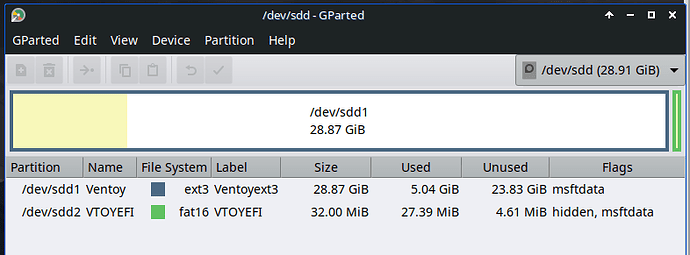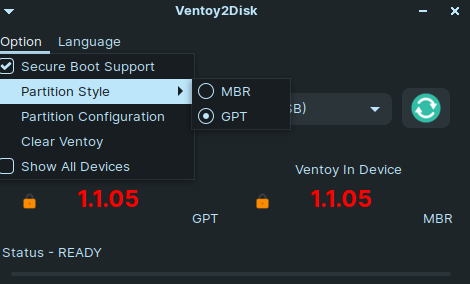I know the systems I have, which is all I need to know.
OK, I see.
Hello Paul
In your instructions there is something missing … formatting … for just and only one time for the first installation of Ventoy is required by the tool itself do a format. It is done by Ventoy.
Just being curious: Is possible for you run GParted within your Linux Distribution to see how is currently structured your USB FLash Drive?
I have Ventoy installed in running in peace in a USB flash drive of 32GB … just in case Ventoy has its own official forum too.
Normally I install and updated Ventoy in Windows 10 and 11.
Built a new Ventoy stick with 1.1.05 - and I can boot Puppy (Slackware 64 bit) and Pop!_OS 24.04 (latest build with Cosmic desktop)…
Also have a Debian Bookworm x86_64 bit Live ISO with gnome on there… Haven’t tried that yet… But better success than previously with Ventoy 1.0.99 - as I was unable to boot Pop!_OS 24.04 previously…
I just went with defaults - on a Dell Latitude - F12 for boot menu, under BIOS (i.e. legacy not UEFI) boot from “USB Storage Device”, then select Puppy or Cosmic and then the “Boot in Normal Mode” option…
With both Puppy and Pop! - it recognised the HDMI monitor and sound worked in Puppy (didn’t try on Pop!) and it showed WiFi and ethernet and internet access…
Just booting Debian now - first time round “Normal Mode” just hung after Debian’s grub…
Tried again in “grub 2 mode” - and Debian boots into Gnome… WiFi is working in live mode… it’s defaulting to Wayland with Gnome 43…
So - that’s 3 O/S that work with Ventoy… Maybe last time round I just needed to be patient and try “grub 2 mode” or something?
Just for sh!ts n giggles I might throw GhostBSD on there and see what happens ![]()
Here is what my Ventoy usb drive looks like in Gparted
I guess the ext3 filesystem contains the loaded distros.
The fat16 filesystem seems to be an EFI partition
I found this info
1. VTOYEFI Partition:
This partition is essential for booting and contains the necessary files for Ventoy to load and manage your ISOs.
It's typically formatted with a file system compatible with the boot process (e.g., FAT32, exFAT).
2. Ventoy Partition:
This is where you'll store your ISO files, which can be any bootable image format (ISO, WIM, IMG, etc.).
The default file system is exFAT, which offers good cross-platform compatibility with Windows, macOS, and Linux.
You can choose to use other file systems like NTFS or FAT32, but exFAT is recommended for its compatibility.
Important Considerations:
Partition Style:
Ventoy supports both MBR and GPT partition styles. If you're using a legacy BIOS system, MBR is necessary.
So my choice of ext3 was not what they recommend.
There is more detail here
It would seem there is a difference between GPT and MBR partitioning setups
I dont know if it is possible to setup a Ventoy flash drive so it will boot in either a legacy boot or a UEFI boot machine. That may be worth some consideration.
I am working away for a few days so will look on my return
Thanks for the Figure …
BTW When I install Ventoy It is just installed … Therefore I did not select any partition type.
If you have ext3 and if I have a different (i.e: fat32 - Remember I installed/upgraded Ventoy in Windows) then:
- I must assume it is according the OS where Ventoy is installed and/or upgraded
Now, Let us wait the Figure of Paul to do a simple comparison
If I need a single distro on a small USB stick, I use Etcher.
I vaguely remember it offered me a choice. I installed Ventoy from Linux. I will go back and check.
When i choose the usb from tye ventoy site it did everything, so i did not have to choose a format type everything automatic
Similar when I download a iso from mint, then use mint to create a boot usb on a smaller usb it does everything for me, never. Checked to see the disk format
Never needed a seperate tool to make a boot usb except in windows but so long ago cannot remember what it was.
As an aside from using Ventoy to install/view a live distro.
The Boxes VM app is something I often use for a quick look at an iso.
Saves booting to a Ventoy USB stick.
It doesn’t work for everything but neither does Ventoy.
Hello Paul
so i did not have to choose a format type everything automatic
Very strange, because for a USB Flash drive: for the unique and first time when Ventoy is installed is indicated (ask for your permission) to format. It is indicated in the Tutorial shared by you in your first post too. I had this experience in 2 different USB Flash Drive
Once Ventoy is installed you can put any .iso files as you need
If you look at the screen shot on answer 29 there is no selection of usb storage type, nor a request to format it, it does not tell you everything will be lost, just a double check you actually want to do it
Yes, but later, it just updates the software, leaving the rest as it is, IIRC.
Hi @callpaul.eu
Are you referring to the info I posted?
Yes … it does not say select format of key, unless its in options which I left alone
Thanks seen it now
Hello Paul
If you look at the screen shot on answer 29 there is no selection of usb storage type, nor a request to format it, it does not tell you everything will be lost, just a double check you actually want to do it
That Figure is taken from a tutorial… It seems the tutorial is incomplete … furthermore in the tutorial shared by you from the beginning is mentioned the format process… and even with a confirmation
Alfred
Yes, but later, it just updates the software, leaving the rest as it is, IIRC.
Correct, for updates there is no format and any current files in the USB Flash drive remain in peace
Hello @Manuel_Jordan
Can you say how you would install Ventoy to a USB stick?

